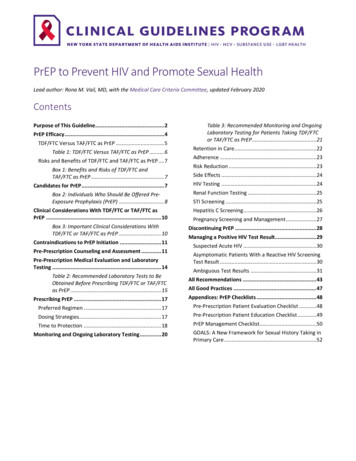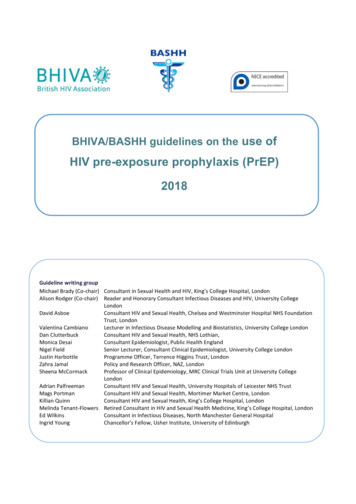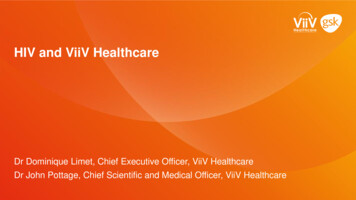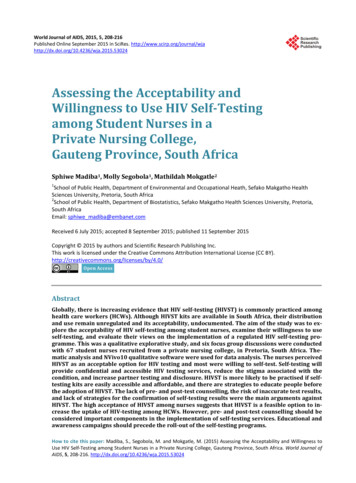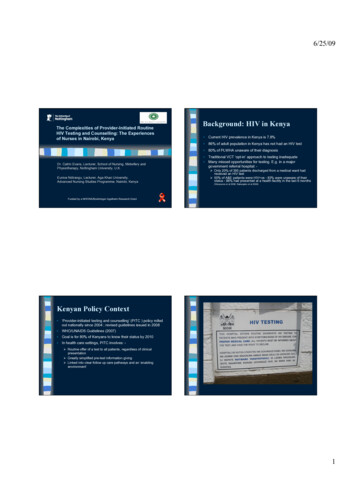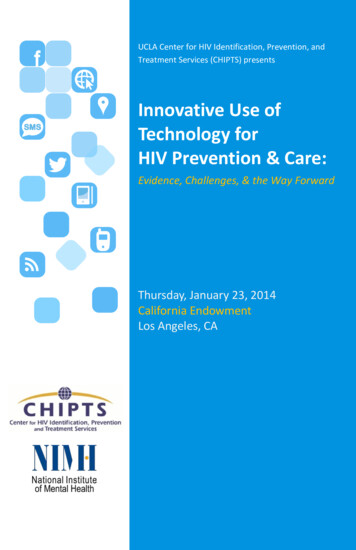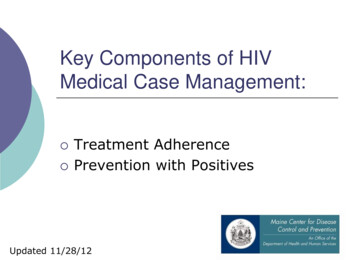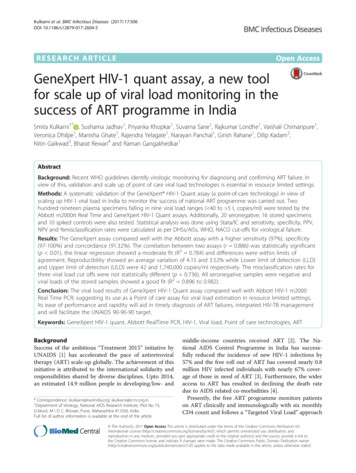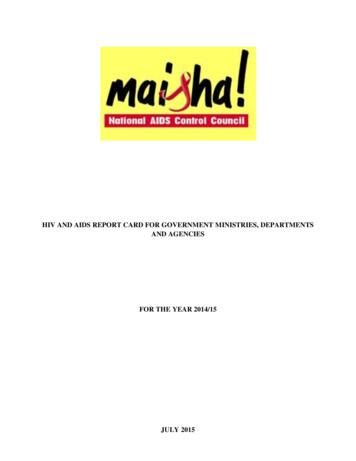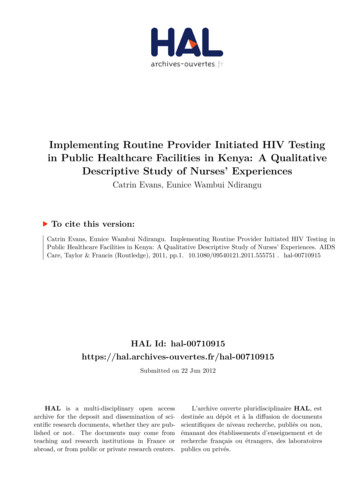
Transcription
Implementing Routine Provider Initiated HIV Testingin Public Healthcare Facilities in Kenya: A QualitativeDescriptive Study of Nurses’ ExperiencesCatrin Evans, Eunice Wambui NdiranguTo cite this version:Catrin Evans, Eunice Wambui Ndirangu. Implementing Routine Provider Initiated HIV Testing inPublic Healthcare Facilities in Kenya: A Qualitative Descriptive Study of Nurses’ Experiences. AIDSCare, Taylor & Francis (Routledge), 2011, pp.1. 10.1080/09540121.2011.555751 . hal-00710915 HAL Id: 0710915Submitted on 22 Jun 2012HAL is a multi-disciplinary open accessarchive for the deposit and dissemination of scientific research documents, whether they are published or not. The documents may come fromteaching and research institutions in France orabroad, or from public or private research centers.L’archive ouverte pluridisciplinaire HAL, estdestinée au dépôt et à la diffusion de documentsscientifiques de niveau recherche, publiés ou non,émanant des établissements d’enseignement et derecherche français ou étrangers, des laboratoirespublics ou privés.
Health SciencesrPFoImplementing Routine Provider Initiated HIV Testing inPublic Healthcare Facilities in Kenya: A QualitativeDescriptive Study of Nurses' ExperienceseeManuscript ID:Journal Selection:AC-2010-09-0525.R1AIDS CareevKeywords:AIDS Care - Psychology, Health & Medicine - Vulnerable Childrenand Youth StudiesrRJournal:HIV, Nurses, Kenya, Provider initiated hm-vcy
Page 1 of 15Health SciencesImplementing Routine Provider Initiated HIV Testing in Public Healthcare Facilities in Kenya: AQualitative Descriptive Study of Nurses' ExperiencesDr. Catrin Evans (Ph.D.), Lecturer, School of Nursing, Nottingham University, B Floor, Queens MedicalCentre, Nottingham, NG7 2UH, U.K. (catrin.evans@nottingham.ac.uk)Ms. Eunice Ndirangu (M.Sc.), Lecturer, Advanced Nursing Studies Programme, Aga Khan University,P.O. Box 39340, Parklands, Nairobi, Kenya, mc.manuscriptcentral.com/ac-phm-vcy
Health SciencesPage 2 of 15Implementing Routine Provider Initiated HIV Testing in Public Healthcare Facilities in Kenya: AQualitative Descriptive Study of Nurses' ExperiencesAbstractRoutine 'provider-initiated testing and counselling' (PITC) for HIV has been implemented amidstconcern over how consent, confidentiality and counselling (the 3C’s) can be maintained in underresourced health care settings. In Kenya, PITC has been rolled out since 2005, HIV prevalence is 7.1%Foand over 86% of adults have not been tested. Kenyan nurses are the main cadre implementing PITCbut little is known about their experiences of incorporating HIV testing into everyday practice andrPthe challenges faced in maintaining the 3’Cs within their work environments. This study aimed toexplore these issues and adopted a qualitative multi-method design using a convenience samplingeeapproach. Two focus group discussions (total n 12) and 13 in-depth individual interviews wereundertaken with nurses from 11 different public health care facilities in Nairobi and its surroundingareas (including in- and out-patient settings). Data were analysed thematically. Nurses identified arRrange of personal, client and health system challenges in the everyday application of PITC. Theseincluded: (i) the contradictions of normalising a highly stigmatised disease and the difficulty ofevproviding client centred care within a routinised and target oriented work culture; (ii) the challengeof dealing with ethically complex client situations in which the principles of the 3C’s could be difficultiewto uphold; and, (iii) lack of time, resources, space and recognition within workplace environments(especially in-patient settings) that, likewise, led to problems with maintaining the 3C’s. In-patientnurses in particular identified problems associated with testing in a multi-disciplinary context,suggesting that other health professionals appeared to routinely flout the PITC guidelines. InOnconclusion, this study shows that the process of translating policy into practice is invariably complexand that more research is needed to explore PITC practices, particularly in in-patient settings. Nursesrequire supervision and support to negotiate the challenges and to fulfil their roles effectively.lyKeywordsHIV; provider initiated testing; nurses, ac-phm-vcy
Page 3 of 15Health SciencesProvider initiated HIV testing and counselling (PITC) is a key strategy in the global effort to increaseHIV testing rates. Global PITC guidelines propose that all clients attending health services in highprevalence areas be offered an HIV test, regardless of their presenting complaint (WHO/UNAIDS,2007). PITC has significant implications for health care teams, requiring increased levels ofengagement with HIV issues, higher work loads and/or the need to re-organise working patterns toincorporate HIV testing into routine care. In response to concerns about the protection of individualrights in resource limited clinical settings (Gruskin, Ahmed, & Ferguson, 2008; Rennie & Behets,2006), WHO/UNAIDS (2007) guidelines state that PITC should only be implemented in contextsFowhere a minimum package of HIV care and the 3C’s – informed (verbal) consent, confidentiality andcounselling can be guaranteed (WHO/UNAIDS, 2007 p.30).eerPKenyan ContextThis paper examines PITC in Kenya where HIV prevalence is 7.1%; over 86% of the adult populationhas not had an HIV test and approximately 83% of people who are HIV positive are unaware of theirrRdiagnosis (Ministry of Health, 2008a). PITC has been progressively rolled out in Kenyan public sectorhealth facilities (which comprise approximately 51% of health services) since 2005 (Marum,evTaegtmeyer, & Chebet, 2006; Ministry of Health, 2009). PITC scale up is supported by nationalguidelines (Ministry of Health, 2008b) and a national health worker training programme. In publiciewsector health facilities, PITC is usually carried out using rapid tests and is primarily undertaken bynurses.Literature ReviewOnResearch from across sub-Saharan Africa shows high levels of patient acceptance of PITC whenmeasured quantitatively (Obermeyer & Osborn, 2007; Wanyenze et al., 2008). However, in Kenya (aslyelsewhere), considerable variation in testing uptake and return for follow up between differenttesting sites has been reported, indicating that specific site factors have an impact on the patientexperience (Anand et al., 2009). A number of qualitative studies highlight that patients can feelpressured into testing, are mistrustful of healthcare staff or report poor quality care (Delva,Mutunga, Quaghebeur, & Temmerman, 2006; Groves, Maman, Msomi, Makhanya, & Moodley, 2010;Hamilton et al., 2008; Painter et al., 2004).3http://mc.manuscriptcentral.com/ac-phm-vcy
Health SciencesPage 4 of 15In Kenya, a 2005 national health worker survey found high levels of knowledge and support for thePITC programme (National AIDS and STD Control Programme, 2006). However, a recent evaluationof the PITC national training programme found that only 30% of health facilities were fullyimplementing PITC citing staff shortages, lack of space and low staff morale as associated factors(Kathambana et al., 2008). Similar findings have been reported in a range of other countries (Evans &Ndirangu, 2009; Minnie, van der Walt, & Klopper, 2009).To date, HIV testing research has focused upon out-patient settings (primarily antenatal or TB clinics).FoVery little is known about PITC practice within in-patient contexts.rPResearch AimeeGiven the critical role of nurses in ensuring high quality PITC implementation in Kenya, this paperreports on an exploratory study that aimed: (i) to investigate key challenges in PITC from a nursingperspective and, (ii) to explore ways in which the principle of the 3C’s (consent, confidentiality andrRcounselling) were being managed in every day practice.evMethodsiewThe study adopted an interpretative qualitative methodology (Rubin & Rubin, 1995). A multi-methoddesign was used, involving 2 focus groups (n 6 in each) and 13 semi-structured interviews (Green &Thorogood, 2004). The focus groups were conducted to explore social/professional norms anddiscourses around HIV testing and of nurses’ role in HIV care. These were followed by individualcontexts (Barbour, 1998).lyOninterviews to elicit accounts of actual HIV testing practices and experiences in particular workplaceData were collected by the second author, a Kenyan nurse-researcher. The sampling strategy wasdeliberately broad in order to represent nurses from a range of workplaces. The inclusion criteriawere that participants had a nursing qualification, worked in a public health sector facility in oraround Nairobi and that they either delivered PITC directly or worked in a setting where PITC directlyimpacted upon their everyday nursing practice (e.g. having to care for in-patients who had justreceived a HIV diagnosis). There were a total of 25 nurse-participants, representing 11 differenthealthcare facilities; 13 worked in in-patient settings and 12 worked in out-patient settings and/orheld managerial positions - see tables 1 and 2 for further y
Page 5 of 15Health SciencesRecruitment for the individual interviews used convenience sampling; the second author contactedhealth facilities (Hospitals A-D and Health Centre A) where she had contacts amongst senior nursingstaff who, in turn, facilitated access to potential participants. The focus group participants likewisecomprised a convenience sample in that they were drawn from a larger group of nurses who wereattending a course (not connected to HIV) in a Nairobi School of Nursing. The interviews (lasting 45 –60 minutes) were held in a quiet room in the individual’s workplace. The focus group discussionswere held in the School of Nursing.FoEthical permission to conduct the study was obtained from the Aga Khan University Research EthicsrPCommittee, the Kenyan Ministry of Education Science and Technology and individual hospital ethicscommittees. All participants provided written informed consent.rReeData AnalysisAll interviews/group discussions were digitally recorded, transcribed and checked for accuracy. Datawere analysed manually using inductive thematic content analysis (Boyatzis, 1998), paying particularevattention to atypical cases and to contextual variations (Tobin & Begley, 2004). Initially, theinterviews and focus groups were analysed separately but strikingly similar themes emerged fromiewboth data sets, so they were combined. To enhance rigour, transcripts were read by both authorsand a common coding scheme and thematic framework was agreed. Three major categories wereidentified.(1) The Contradictions of RoutinisationlyOnFindingsAll the nurse participants were highly knowledgeable about the PITC policy and supported itsrationale. However, nurses identified two contradictions that PITC posed for their everyday practice.The first was associated with trying to normalise a highly stigmatised disease. On the one hand,many nurses noted that the routine offer of a test made HIV seem “just like any other chronicdisease”, and that, in practice, routinisation made it easier for both staff and patients to talk aboutHIV. So, whereas previously, ‘HIV-talk’ had been conducted using coded forms of communication(e.g. oblique references by health-workers to “P-24 antigen”) or by complicated guess work based5http://mc.manuscriptcentral.com/ac-phm-vcy
Health SciencesPage 6 of 15on indirect hints from patients (e.g. references to “weight loss”), nurses felt that routinisation nowfacilitated more open conversations:Before, a patient will come - inside his heart wanting to do the test - but just asking youwould be a problem for him, but now its all in the open (N13)On the other hand, nurses recognised that in the public mind HIV was not yet a ‘routine’ illness dueto the stigma that surrounded it. Indeed, many participants commented that some nursesFothemselves still stigmatised HIV and could exhibit a damaging judgementalism:rPWe talk as if it’s a bad thing; we also discuss these patients despite saying that we are goingto keep the confidentiality - so of course patients will not want to test (FGD1, P5)eeThe second contradiction was associated with trying to maintain a client centred philosophy of carewithin a routinised and target driven practice context. For example, many nurses were notrRconvinced about the PITC guideline to minimise pre-test discussions in order to expedite clientthrough-put. Their own experience was that in many cases (because of HIV-related stigma), patientsevdid require in-depth pre-test discussions to help them to overcome their fears and to give consent:iewPre-test counselling is the most important thing because it prepares the patient to receive apositive result – if you just test - where do you start when the patient turns out to be positive?(FGD2, P3)OnIn such cases, nurses’ narratives indicated that, where possible, they adapted the guidelines,tailoring their discussions to an in-depth understanding of the patients’ situation:lyWith this patient, I knew I had to take longer. So I took her very slowly through everything.She didn’t want to test, but then, after some persuasion, she decided to let me go ahead(N12)Many of the participants (particularly from out-patient settings) felt that routine testing had createda target- rather than client-centred approach to HIV care and that this inevitably compromisedquality of care:6http://mc.manuscriptcentral.com/ac-phm-vcy
Page 7 of 15Health SciencesIf you see the crowds at the clinic they [the supervisors] will be very happy but they willnot bother to find out the quality of work you did with each client .They are pressurizing thestaff if you do not test this many numbers then you are a failure and we arewondering where this 50 will come from. If we coerce these patients to be tested - then theywon’t come back. It won’t be provider-initiated, it will be provider-coercion (FGD2, P1)(2) Everyday EthicsFoThe data indicated that PITC sometimes created acute ethical dilemmas within nurses’ everydaypractice which were experienced as very stressful.rPA commonly cited situation was where patients refused to have the HIV test. In dealing with suchcases, nurses repeatedly returned to the principle of “do no harm” to justify their decision making.eeSo, for example, nurses noted that they would usually give the patient more time or simply have toaccept the patient’s choice (even if they did not agree with it). However, a number of nursesrRdescribed situations where they had applied strong pressure to persuade patients to take the test. Inprinciple, this runs counter to the PITC guidelines to elicit voluntary informed consent. In theexamples given however, nurses clearly felt that not testing would have caused even greater harm:evSometimes you find a patient where you know the spouse or a child has died because of AIDSiewand they refuse to be tested despite the counselling and all that. It is challenging becauseupon discharge you will lose that patient. So you find you might be aggressive for the sake ofhelping them, not because you want to create harm, but just because you want them tobenefit, even though you have to use a cold and aggressive way of handling such aOnsituation .Like there was a girl on the ward and I told her – either you lose your life orcomply with the protocols of the hospital .then, you see .it was like forcing butlyat the end of it she accepted. But it was for her benefit (N2)None of the participants mentioned the multi-disciplinary team as a source of advice in dealing withsuch situations. In fact, several interviewees (all from in-patient settings) described incidents wheremedical doctors or clinical officers had tested patients without consent, indicating that this wascommon practice:It happens many times when the doctors are doing their rounds. Many are the times theydon’t inform the patients what is wrong with them. The doctor notes down the test and the7http://mc.manuscriptcentral.com/ac-phm-vcy
Health SciencesPage 8 of 15next thing you know, the clinical officer is poking into this patient drawing blood and thepatient doesn’t know why. The patients are so innocent, they trust that whatever you aredoing is for his own good . they do not demand to know (N6)Interestingly, all such narratives were recounted without comment or judgement. When the nurseswere asked if they ever questioned the practice of a doctor, they indicated that their views would bedismissed:FoSometimes we do suggest about patient management with the doctor but then the doctorsfeel you are undermining them – you know – you are just a nurse (N5)rPAnother difficult situation was when HIV positive clients refused to disclose their status to otherseewho were potentially at risk. Again, in most cases, nurses spoke of having to accept and respect apatient’s choice. Nonetheless, in four interviews, nurses admitted to breaching confidentiality. In allfour cases, the situation involved a male patient refusing to inform a spouse and was rationalised inrRterms of acting in the public good:evYou know, this whole issue is gender biased because the men, they keep it to themselves andthe women perish. That part of the confidentiality - I think it’s killing us. It should beiewmandatory that the spouse news is told to the other spouse. It is not opening up otherpeople’s issues, but it is just taking care of the others (FGD1, P4)Nurses described a deep discomfort in dealing with a related scenario in which the family wasOnanxious, was bearing a high financial and physical burden of care, and yet the patient would notdisclose. Some nurses felt it was ethically wrong to keep such relatives in the dark:lySee, the relative is the one paying the bill and they are asking all the time ‘what has thedoctor said’? . As a nurse you are fixed because on the one hand there is confidentiality andon the other there is the relatives’ vulnerability .Mostly it is women, and you see thatthey will not be able to take care, so you just go ahead and give information to that person(N10)Nurses also described becoming de-moralised at the sheer number of patients who tested positiveand at their sense of powerlessness to help those in need:8http://mc.manuscriptcentral.com/ac-phm-vcy
Page 9 of 15Health SciencesYou test them and then they tell you their history and you just don’t know what to do next.They are poor and they can’t afford food, and then you ask yourself ‘what can I do to helpthis person’. It really affects me (N10)Working with HIV therefore exacted an emotional toll. In some institutions, specialist HIVcounsellors received monthly clinical supervision, however, this was not available everywhere anddid not include general clinic/ward nurses.Fo(3) Workplace Environment and SupportrPA major source of stress and frustration for the participants related to their working environments.eeLack of staff, lack of resources and lack of time were the most common complaints leading topatients being kept waiting, being sent away un-tested or being dealt with abruptly.rRSometimes you find like in my ward you are alone .you have all the clients for testing – sowhat we do is sketchy – you know – shallow, not deep (N11)evMany nurses identified the over-crowded ward environment (where beds are shared or positionedchallenge to maintaining dignity and confidentiality:iewclose together, where there are no screens and where relatives may be present at all times) as aWe don’t have cubicles .so it forces us to go bed by bed as we give a report .patients haveOncome to realise the language we use and then you say “this immuno-suppressed patient orthis is a p24 patient” and it just gives away the whole story t
Very little is known about PITC practice within in-patient contexts. Research Aim Given the critical role of nurses in ensuring high quality PITC implementation in Kenya, this paper reports on an exploratory study that aimed: (i) to investigate key challenges

